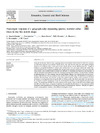Please use this identifier to cite or link to this item:
https://accedacris.ulpgc.es/handle/10553/132198
| Title: | Phenotypic response of a geographically expanding species, Scomber colias: clues in the fish otolith shape | Authors: | Jurado-Ruzafa, A. Vasconcelos, Joana Otero-Ferrer, J.L. Navarro, M.R. Massaro, A. Hernández, C. Tuset, V. M. |
UNESCO Clasification: | 251005 Zoología marina | Keywords: | Otolith Contour Phenotypes Resilience Scomber Colias Stocks |
Issue Date: | 2024 | Journal: | Estuarine, Coastal and Shelf Science | Abstract: | During the last decades, there has been a growing interest in the Atlantic chub mackerel, Scomber colias, owing to its northward expansion across the East Atlantic Ocean. This trend has been observed from regions of higher abundance off northwest Africa to the waters of the Atlantic Iberian and the Mediterranean Sea. Changes in abundance and spatial distribution of Atlantic chub mackerel have been previously studied and various theoretical models have been proposed to elucidate the changes in its abundance and biomass. However, within this fishing context, only a limited number of studies have attempted to understand how this species has responded at both the individual and population levels to the changing environmental conditions. The phenotypic variability of 1660 individuals of S. colias collected from the Canary Islands, Madeira, the Cantabrian Sea and the Central-Northern Mediterranean Sea was examined, with a specific focus on otolith shape. We identified six morphotypes classified into two groups and associated to the four analyzed regions. Despite of the occurrence of shared phenotypes in varying proportions among the different fishing grounds, this classification might be explained by the adaptation of certain morphotypes to specific environmental conditions and the migratory behavior of this species. The morphotypes M1-M5 were more abundant in the warmer waters of Madeira-Canary Islands region and M6 in the colder waters of Ligurian-Cantabrian. It is plausible that the former set may represent resident contingents, while morphotypes M2-M3 and M4 are likely to exhibit migratory behavior. Therefore, we suggest a complex metapopulation structure, where different contingents coexist. | URI: | https://accedacris.ulpgc.es/handle/10553/132198 | ISSN: | 0272-7714 | DOI: | 10.1016/j.ecss.2024.108880 | Source: | Estuarine, Coastal and Shelf Science[ISSN 0272-7714], v. 305, (108880), (Octubre 2024) |
| Appears in Collections: | Artículos |
SCOPUSTM
Citations
5
checked on Jun 8, 2025
WEB OF SCIENCETM
Citations
5
checked on Jun 8, 2025
Page view(s)
77
checked on Mar 1, 2025
Download(s)
18
checked on Mar 1, 2025
Google ScholarTM
Check
Altmetric
Share
Export metadata
Items in accedaCRIS are protected by copyright, with all rights reserved, unless otherwise indicated.
